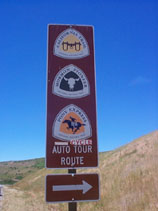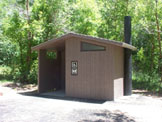Bulletin Board
|
Big Mountain: Mormon and Pony Express Trail
New Hiking Trail to Honor Pioneers
July 10, 2000
Standing atop Big Mountain summit at 7,420 feet above sea level, between Morgan and Salt Lake Counties, Utah, looking west is a splendid vista of the Wasatch Mountains. In the far background is a glimpse of the Salt Lake valley. This view welcomed thousands of early emigrants as they settled the Great Basin. Later the trail would be the Pony Express route to and from Salt Lake City. In a relatively short time period, this main route was abandoned. The early migration of Mormon Pioneers lasted for about 20 years, and the Pony Express was short lived, lasting only 18-months. In 1865 Parleys Canyon became the main gateway to Salt Lake City. Today I-80 passes through Parleys Canyon.
No longer a major transportation corridor, the Mormon Trail is now State Road 65 taking recreationalists to East Canyon. The highway is closed during the winter months above Little Dell Reservoir. In commemoration
of the early pioneers, a 4-foot wide Pioneer Historic Trail between Big Mountain and Little Dell Reservoir has been constructed. Big Mountain is located on State Highway 65 about 8.2 miles north of I-80 in Parleys
Canyon, Utah, which is about 5 miles east of Salt Lake City. To reach State Highway 65 from I-80, take the East Canyon Exit 134. It is 2.9 miles to the Little Dell Recreation site and 5.2 miles to Affleck Park.

Mormon Pioneers
Big Mountain has special historic significance. It is where the early pioneers saw their first glimpse of the Salt Lake valley. On July 23, 1847 Brigham Young first viewed the Salt Lake valley from this viewpoint. His account reads, "I ascended and crossed over the Big Mountain, when on its summit I directed Elder Woodruff, who kindly tendered me the use of his carriage, to turn the same half way round, so that I could have a view of a portion of Salt Lake valley, and I felt that there the saints would find protection and safety. We descended and encamped at the foot of the Little Mountain."
According to the momument located on Big Mountain summit entitled, “The Road to Zion, ‘70,000 Mormons passed by here on their way to their ‘New Zion,’ in Utah.” The trail often following routes blazed by earlier emigrants, stretched nearly 1,400 miles across prairies and mountain barriers, from Council Bluffs to the Salt Lake valley and opened up the colonization of the Great Basin.
On July 24, 1847 after passing through Echo Canyon, over Big Mountain and Little Mountain and down Emigration Canyon, according to Wilford Woodruff’s memory, an ill Brigham Young said, “It is enough. This is the right place.”
It is believed that that between 3,000 and 6,000 perished due to sickness, harsh weather and the elements. This westward migration led to the settlement of Utah and Nevada and portions of Colorado, Idaho, Wyoming, Nevada, New Mexico and Arizona.
The Mormon Trail was the passage through which thousands settled the Great Basin. Big Mountain is symbolic of this enormous event in American history. The first sight of their final destination must have been a sight of great joy for those emigrants who traveled such a great distance to find their future.
Pony Express
In a book entitled Utah and the Pony Express, author Kate B. Carter wrote that the idea of the Pony Express was born in 1854 when William M. Quin, United States Senator from California, rode horseback from Sacramento by way of Salt Lake City and Fort Laramie to St. Joseph, Missouri. He and Benjamin F. Ficklin, superintendent of the freighting firm of Russell, Majors & Waddell, discussed the idea of having a more adequate overland mail delivery system. The following year Senator Quin introduced a bill in Congress providing for a weekly mail each way between St. Louis and San Francisco.
|
|
The Pony Express lasted 18 months. The visions of young riders carrying the mail cross county caught America's imagination and spirit of adventure. It lives today as an American legend.
The Mt. Dell Station was located below Big Mountain. The marker there reads, "In 1857, Ephraim Hanks established a ranch and way station for travelers near the evergreens in the canyon below. It served as an Overland Stage stop and a Pony Express station." The marker is a lasting remembrance of the Pony Express whose riders traveled from St. Joseph, Missouri to Sacramento, California.
Pioneer Historic Trail Constructed
In March of 1997, the Salt Lake City Department of Public Utilities applied for a $93,000 grant from the Utah State Parks and Recreation Division to re-establish the Historic Pioneer Trail in Mt. Dell Canyon between Big Mountain and Little Dell Reservoir. In December of that same year, the State approved a lesser amount of $74,000.
The Department of Public Utilities entered into a partnership with the U. S. Forest Service to construct the trail for $36,000. The remaining grant was used to construct public restrooms at a cost of $36,000. Signage along the trail will expend the remaining grant money.
According to Russ Hone, Watershed Administrator, the new 4-foot wide section of trail is approximately 3 miles in length, connecting the existing Little Dell trail, which is approximately 2 miles long, making a total of 5 miles of trail constructed during the past 3 years. The trail can be accessed at the Little Dell Recreation Area, the stream crossing below Affleck Park, Affleck Park, one mile above Affleck Park and Big Mountain. All access points are located along State Road 65.
|
|
Hone says the trail is for hiking and mountain biking. Motorized vehicles are prohibited. Hone believes that the trail will attract families for a leisure hiking experience, "The fun part of the trail is that it is designed for the family. The trail is not steep, and the length can be as short as one-half mile and up to the trail's full length of 5 miles."
The trail is also part of a larger trail system as it connects with the Great Western Trail, which eventually will run the full length of the Rockies from Canada to Mexico.
Questions regarding this article should be directed to: russ.hone@ci.slc.ut.us


